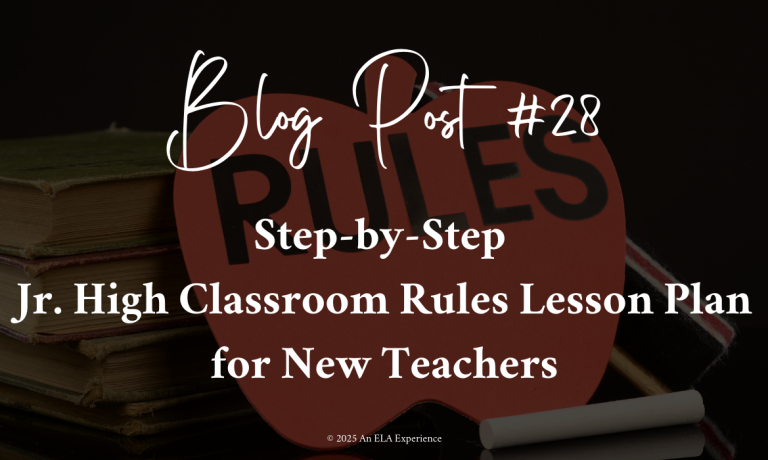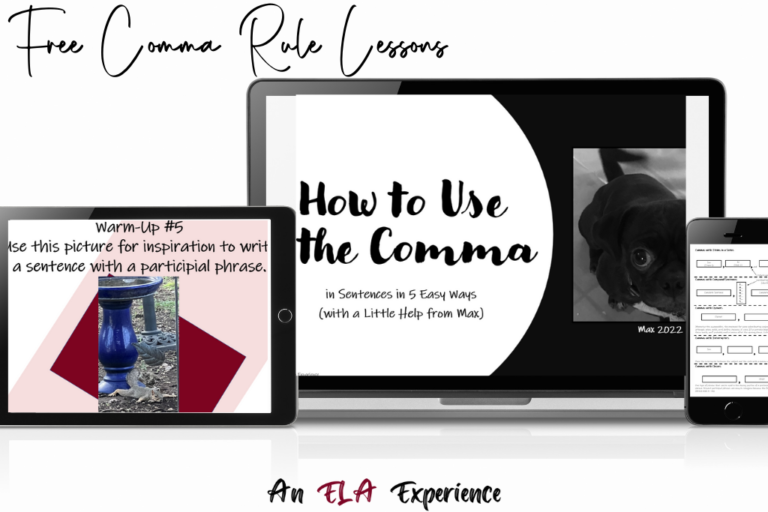When I first started teaching, there were a few strategies I got right when it came to teaching junior high classroom rules:
- Introduce them on the first day of school.
- Keep the number of rules to a minimum.
- State the rules positively (e.g., arrive to class on time instead of don’t be tardy).
And there was at least one thing I got wrong:
- Lecture the entire period.

In my defense, I taught classroom rules as I had been taught, which worked well enough in the late 1900s (when I started teaching). But it’s now 2025, and today’s students need more (e.g., more socializing, entertainment, thinking, understanding, etc.). With this in mind, I’ve designed a lesson that steps away from lecture while helping students understand the reasons behind the rules.
This post will explain what to do from the beginning until the end, but if you want my slideshow and handouts, visit “Classroom Rules Lesson Plan” in my TPT store.
Before the Junior High Classroom Rules Lesson
Implement a lesson that fits your teaching style and your students’ learning styles.

This classroom rules lesson plan is collaborative and designed to get students thinking about why teachers have rules and to narrow these expectations down to one guiding principle: respect, respect for themselves and others. I mention this because some may prefer a more sedate environment when introducing rules at the beginning of the year. Others may think a rule focusing on respect is overly broad (although I argue that students will understand respect if taught what it encompasses).
At the same time, teachers need to meet their students’ learning styles. (Granted, on the first day of school, you’re not yet familiar with their individual needs, but I promise they will be more engaged if they’re collaborating instead of just listening.)
Decide which rules you want to cover.

To do this, think about what rules are most important to you, along with school rules. For example, here are three behaviors I expect to see:
Arrive to class on time.
Complete all assignments.
Keep cell phones and earbuds in your backpack.
You’ll also want to think about what rules you don’t want to use in your classroom. For instance, I allow my students to eat healthy snacks during class. Why? Many students have early or late lunch periods, while others have nurse passes because of health concerns, and I don’t want to single them out.
For this lesson, I use 10 questions because I usually have around 30 students in each class. This allows for small groups with 3 members each, no more than 3-4 for classes with 32.
Form your class rules into questions, focusing on the why behind the rule.
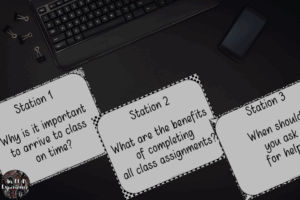
Begin your questions with the five w’s or the h (who, what, when, where, why, or how). For example, the rules noted above can be worded as follows:
Why is it important to arrive to class on time?
What are the benefits of completing all assignments on time?
Why do teachers have strict cell phone and earbud rules?
Type each question onto a slideshow with one question per slide.
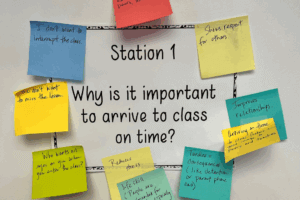
These will serve as your stations/station handouts, whether you choose the butcher paper or sticky note activity. You will place them on top of the butcher paper or tape them to the wall, depending on the activity you choose.
Decide whether you prefer butcher paper or sticky note stations.
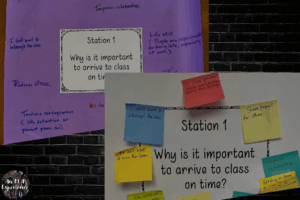
Your decision will probably be based on the materials your school provides. If you have plenty of butcher paper (or large sheets of construction paper), choose the butcher paper stations. If you have enough sticky notes for each student to have 10, choose the sticky note stations.
With the butcher paper stations, group desks together and place a sheet of butcher paper with a question handout on the top. Students will write their responses to the questions on the butcher paper.
With the sticky note stations, tape the question handouts to the walls of your classroom. Students will record their responses on sticky notes and post them around the handouts.
Butcher Paper Stations
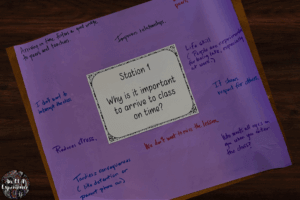
Supplies
- Station handouts/rule questions (Print one set. You can reuse them for each class.)
- 10 sheets of butcher paper or large construction paper per class (for 10 stations)
- 3-4 markers per station
Before Class
Arrange student desks into groups of four.
Place the butcher or construction paper on top of each set of desks and one question handout on top of the butcher paper.
Sticky Note Stations
Supplies
- Station handouts/rule questions (Print one set. You can reuse them for each class.)
- Plenty of sticky notes for students to record their responses (Each student will need one sticky note for each station, so if you have 10 stations and a class of 30, you’ll need 300 sticky notes.)
Before Class
Tape the station handouts onto the walls around your classroom (with a few feet between each station so that you don’t have too many students in one area).
During the Junior High Classroom Rules Lesson Plan
- Play Aretha Franklin’s “Respect” as students enter the classroom.
- Review goals and directions. Students will work at each station, discussing and noting their responses on butcher paper or sticky notes until the timer ends. They will then rotate to the next station.
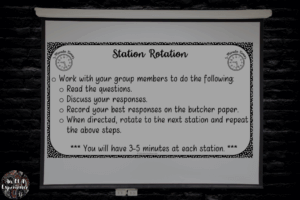
- Set a timer for 3-5 minutes, and monitor and assist students as they work at the stations.
- After students have visited each station, ask them to present to the class by reading the question and the responses from the station they are seated or standing at.
- Close the lesson with a discussion of one rule they can live by that covers all the topics discussed at each station: Respect, respect for yourself and others.
After the Junior High Classroom Rules Lesson Plan
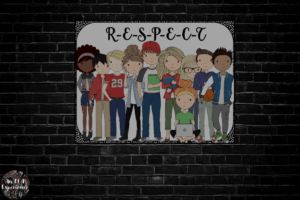
- To remind students of the lesson, post the respect rule in your classroom. Just type it onto a sheet of paper in a large font that can be easily read and referred to.
- Also do one of the following:
- Leave the sticky note stations on your classroom walls.
- Tape the butcher paper stations to your walls.
- Type the rules you covered, and post them to the walls. (These work nicely around the respect rule in a map-type format.)
- Prepare for absent students. On the first day of school, you will have some missing students. If you used the sticky note station, they can visit the stations when they have a free moment. If you want more accountability, give them a handout with the same questions as you used in the activity.
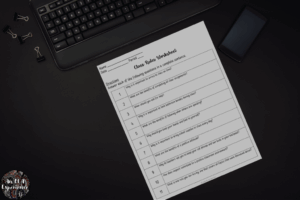
- Revisit the rules throughout the year through discussion, role play, and daily routines.
- Consider posting a respect-related rule on the board each week during the school year. Ron Clark’s The Essential 55 will give you 57 ideas. Click on “read sample” at the above link for a list.
- Remember to let students know of the consequences for breaking the rules. They should be clear from the beginning, fair and consistent, and focus on the behavior (not the student). I follow school policies for rules that address tardies, for example, but I use these for my classroom rules:
- 1st offense–Teacher-student conference
- 2nd offense–Parent phone call
- 3rd offense–Referral to school counselor
- 4th offense–Detention with parent phone call (I was blessed with an administration who provided an after-school d-hall we could assign students to, but you can hold a lunch detention with administrator approval.)
- 5th offense–Office referral
- Reinforce positive behaviors with verbal praise, positive parent phone calls, and other incentives. (I love catching kids being good and rewarding them with a sticker on their hand or face, whichever they prefer. When I start doing this, I tell them to point to where they want it placed. If they don’t notice me in time to point, I stick it on the back of their hands.)
Related Links for Junior High Classroom Rules
Visit Classroom Rules Lesson Plan on TPT to purchase my slideshow and handouts.
You can find twenty-two classroom rules at The 22 Best Classroom Rules for Middle School You’ll Want to Try.
If you’re looking for activities to practice your classroom rules, visit Bringing Classroom Rules to Life | Responsive Classroom.
For more information on establishing rule and consequences, visit How to Establish a Rules-and-Consequences System in the Classroom | Teach For America.
Visit What Are Good Classroom Rules for Your Classroom and School? for guidelines for creating rules and some free printables.
In a Nutshell
I’ve learned a lot about teaching since those first years, and I’ve found that most middle school students, sometimes all, meet my expectations because they know the behaviors I expect. I’d love to know how my junior high classroom rules lesson plan worked in your classroom, so please feel free to leave a comment.

